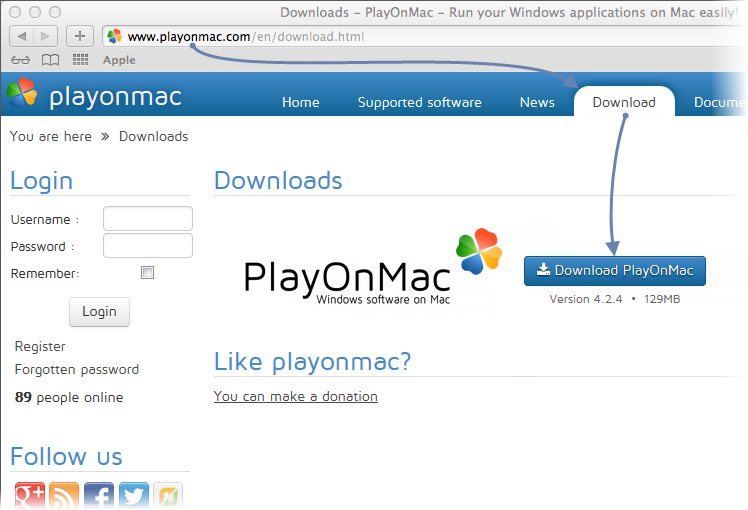Install Wine On Mac Os X
Posted : admin On 03.01.2021Installing Wine on Mac. This tutorial is for intermediate users who want to install and use Wine on their computer running macOS. You should already know the basics of how to use the command line. Mar 12, 2020 I wanted to run a Windows machine on my Mac OS X. So obvious choice was using WineHQ. Ideally, it should have been 1/ Download, 2/ Install and 3/ Run. However, it is never that simple, isn’t it!? Configuration of iMac macOS Catalina (10.15.1) iMac (21.5-inch, Late 2102) Steps for Running WineHQ on macOS Catalina. How to Download Wine on a Mac. RELATED: 5 Ways to Run Windows Software on a Mac There are several ways to get Wine on a Mac. The official project website at WineHQ now provides official builds of Wine for Mac OS X. However, those aren’t necessarily the best option.
Dec 28, 2013 Here is a Step by Step Guide with Video. We previously described the methods to install Wine and Winebottler on Mac OS X – that is not mandatory to read for going through this guide, although it is good to at least have a quick look on that article before installing Wine on OS X. Feb 12, 2014 How To Run Windows Programs On Mac For Free With Wine Bottler (OS X Mavericks) 2014 Wine: Thanks for watching! Brew cask install xquartz To install wine the following command can be used; brew cask install (selected wine package) wine-stable, wine-devel or wine-staging packages can be installed using the above example. The advantage of installing via homebrew means wine is available from a standard terminal session Building Wine. See Building Wine on macOS.
Latest Version:
Wine 5.0 LATEST
Requirements:
Mac OS X 10.8 or later
Author / Product:
Wine Team / Wine for Mac
Old Versions:
Filename:
winehq-devel-5.0.pkg
Details:
Wine for Mac 2020 full offline installer setup for Mac
Note: this listing is for the official release of Wine, which only provides source code. If you want a version of Wine that is packaged specifically for macOS, then use WineBottler!

These advanced steps are primarily for system administrators and others who are familiar with the command line. You don't need a bootable installer to upgrade macOS or reinstall macOS, but it can be useful when you want to install on multiple computers without downloading the installer each time.
Download macOS
Find the appropriate download link in the upgrade instructions for each macOS version:
macOS Catalina, macOS Mojave, ormacOS High Sierra
Installers for each of these macOS versions download directly to your Applications folder as an app named Install macOS Catalina, Install macOS Mojave, or Install macOS High Sierra. If the installer opens after downloading, quit it without continuing installation. Important: To get the correct installer, download from a Mac that is using macOS Sierra 10.12.5 or later, or El Capitan 10.11.6. Enterprise administrators, please download from Apple, not a locally hosted software-update server.

OS X El Capitan
El Capitan downloads as a disk image. On a Mac that is compatible with El Capitan, open the disk image and run the installer within, named InstallMacOSX.pkg. It installs an app named Install OS X El Capitan into your Applications folder. You will create the bootable installer from this app, not from the disk image or .pkg installer.
Use the 'createinstallmedia' command in Terminal
- Connect the USB flash drive or other volume that you're using for the bootable installer. Make sure that it has at least 12GB of available storage and is formatted as Mac OS Extended.
- Open Terminal, which is in the Utilities folder of your Applications folder.
- Type or paste one of the following commands in Terminal. These assume that the installer is still in your Applications folder, and MyVolume is the name of the USB flash drive or other volume you're using. If it has a different name, replace
MyVolumein these commands with the name of your volume.
Catalina:*
Mojave:*
High Sierra:*
El Capitan: - Press Return after typing the command.
- When prompted, type your administrator password and press Return again. Terminal doesn't show any characters as you type your password.
- When prompted, type
Yto confirm that you want to erase the volume, then press Return. Terminal shows the progress as the bootable installer is created. - When Terminal says that it's done, the volume will have the same name as the installer you downloaded, such as Install macOS Catalina. You can now quit Terminal and eject the volume.
* If your Mac is using macOS Sierra or earlier, include the --applicationpath argument, similar to the way this argument is used in the command for El Capitan.
Use the bootable installer
Install Wine On Mac Os
After creating the bootable installer, follow these steps to use it:
- Plug the bootable installer into a compatible Mac.
- Use Startup Manager or Startup Disk preferences to select the bootable installer as the startup disk, then start up from it. Your Mac will start up to macOS Recovery.
Learn about selecting a startup disk, including what to do if your Mac doesn't start up from it. - Choose your language, if prompted.
- A bootable installer doesn't download macOS from the Internet, but it does require the Internet to get information specific to your Mac model, such as firmware updates. If you need to connect to a Wi-Fi network, use the Wi-Fi menu in the menu bar.
- Select Install macOS (or Install OS X) from the Utilities window, then click Continue and follow the onscreen instructions.
Learn more
For more information about the createinstallmedia command and the arguments that you can use with it, make sure that the macOS installer is in your Applications folder, then enter this path in Terminal:
Catalina:
Mojave:
Using Wine On Mac
High Sierra:
Wine Install Mac Os X 10.6
El Capitan: